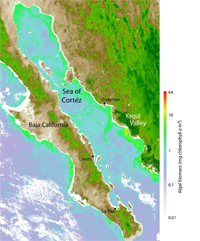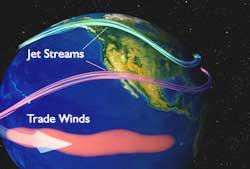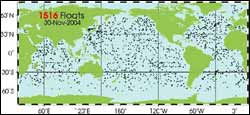
Scientists have found the first direct evidence linking large-scale coastal farming to massive blooms of marine algae that are potentially harmful to ocean life and fisheries.
Researchers from Stanford University’s School of Earth Sciences made the discovery by analyzing satellite images of Mexico’s Sea of Cortez, also known as the Gulf of California-a narrow, 700-mile-long stretch of the Pacific Ocean that separates the Mexican mainland from the Baja California Peninsu

In 30 years, a nuclear-powered space exploration mission to Neptune and its moons may begin to reveal some of our solar system’s most elusive secrets about the formation of its planets — and recently discovered ones that developed around other stars. This vision of the future is the focus of a 12-month planning study conducted by a diverse team of experts led by Boeing Satellite Systems and funded by NASA. It is one of 15 “Vision Mission” studies intended to develop concepts in the United State
There is undeniable proof that water once existed on the planet Mars, a team of researchers has concluded in a series of 11 articles this week in a special issue of the journal Science.
A team of more than 100 scientists from numerous government agencies and universities, among them Mark Lemmon of Texas A&M University’s College of Geosciences, co-wrote the articles. Lemmon was the principal author on one article and co-author on three others describing the work of Spiri
The world’s fastest glacier, Greenland’s Jakobshavn Isbrae, doubled its speed between 1997 and 2003. The rapid movement of ice from land into the sea provides key evidence of newly discovered relationships between ice sheets, sea level rise and climate warming.
The findings were reported in the journal Nature on December 2, 2004. Co-authoring the study was University of New Hampshire glaciologist Mark Fahnestock of the Institute for the Study of Earth, Oceans, and Space (

Scientists studied the winds and rains in the eastern Indian Ocean for hints at developing El Ninos. They used that information to create an “Index” or gauge that accurately predicted the El Nino of 2002-2003.
El Nino is signaled by a warming of the ocean surface off the western coast of South America that occurs every 4 to 12 years when cold, nutrient-rich water does not come up from the ocean bottom. It causes die-offs of plankton and fish and affects Pacific jet stream winds,

International network reaches 1,500th float deployment-halfway to full array
Note: This news release is issued in conjunction with the Group on Earth Observations (GEO-5) and the Partnership for Observation of the Global Oceans (POGO-6) international meetings held the week of Nov. 29, 2004.
Scientists have crossed an important threshold in an international effort to deploy a global network of robotic instruments to monitor and investigate important changes in the world’s oc